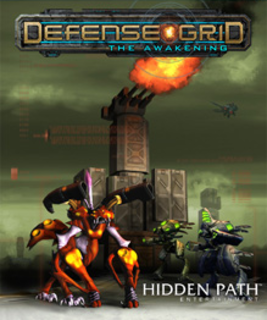A solid single-player tower defense game with just enough twists in design to make it stand out.
For those who haven't tried a tower defense game, the basic gist of it is: Enemies come out of one or more parts of the map, then progress across the map toward one or more exits. The goal is to build defensive towers on the map that will destroy the enemies before they can reach the exits. Each enemy you kill grants more resources to build or upgrade more towers, and as the map progresses the enemies will also get progressively tougher. The fun, then, comes from designing a strategy for picking and laying out towers, as well as adjusting your strategy on the fly as you gain more resources for new and better towers.
Defense Grid has all the expected elements of tower defense. There are different types of enemies (fast ones, tough ones, bosses, flying ones, etc.), and there are ten tower types with two upgrades each. Different towers can be more effective against some enemies than others. The twenty maps are a mix of maze-type maps (where the enemies follow a set path, and you arrange towers along that path) and maps that are part maze, part open (so that it's advantageous to arrange towers on those maps to either create a mini-maze in an open space, or to use towers to block some paths on the map to force enemies to take longer routes to the exit).
The game has three dimensions, unlike WC3 tower defense maps, so towers are affected by line of sight issues, both from terrain and other towers. This adds a very nice bit of extra complexity to tower placement. Placing one gun tower behind another means that when an enemy walks by the front gun tower, the one in the rear won't be able to fire on it. When the enemy is to either side of the front tower, however, the rear tower has line of sight and can attack it. Some towers have area effects or lob their projectiles, making them better choices for the rear lines. Others have slower rates of fire and long range, so they don't lose as many chances to fire on enemies when another tower creates a blind spot for them. And a tower's range is calculated on the z axis as well as on its own plane, so placing a long-range tower on the edge of a high platform does allow it to fire on enemies a level or two below. Overall it adds to the fun of working out your strategy, since tower placement has to be concerned not just with where the enemy will be but also where your other towers will be.
Rather than having "lives" that are lost when enemies reach the exit, you're protecting a power source that has several "cores". When an enemy makes it to your power source it grabs one to three cores (depending on the enemy) and tries to make it to the exit with them. If you destroy an enemy carrying cores, the freed cores will slowly make their way back to your power source, and can be picked up by a passing enemy if they cross paths with one. So while the power source does add an extra waypoint for enemies in their journey from the entrance to the exit, an enemy can grab a dropped power core and take off on a different route to the exit than normal if you aren't careful.
There is a campaign that introduces you to the maps, but the story is pretty simplistic. As you progress through the campaign it opens up more towers, helping newcomers ease into the game, as well as introducing new enemy types. Once you beat a map in the campaign mode you open several other modes of play for that map - one mode gives you stronger enemies, another will send endless waves at you until you lose, another gives you a flat number of resources for tower building at the outset but you don't earn any as the game goes on, and a couple others. It definitely adds to the replay value of the game.
The Steam version of Defense Grid includes Steam achievements, if you like to have those bragging rights attached to your account. Since the game can be purchased from other online distributors as well, I assume that's a Steam-only feature.
Defense Grid isn't perfect, of course. For starters, while the twenty maps included with the game seem well-designed, there isn't a map editor or any additional maps to download at this time. There also isn't any multiplayer, which is a shame - multiplayer TD is a blast. The developer has said in a forum post that they've looked at multiplayer and would love to add it, but it doesn't sound like they would manage to do it anytime soon. It also suffers a bit from the fact that it is just a TD game, and doesn't support any other modes or extra play types like one could get from downloading many of the WC3 TD variant maps out there. Still, for the low asking price, the game can be forgiven for its focus, I would say - you get a lot of good fun for the money.
In short, Defense Grid is a solid game of tower defense with enough twists in its design to make it stand out from other tower defense efforts. If you enjoy that style of gameplay and can live without multiplayer, or if you dig up their demo and think it looks like fun, it's worth buying.

